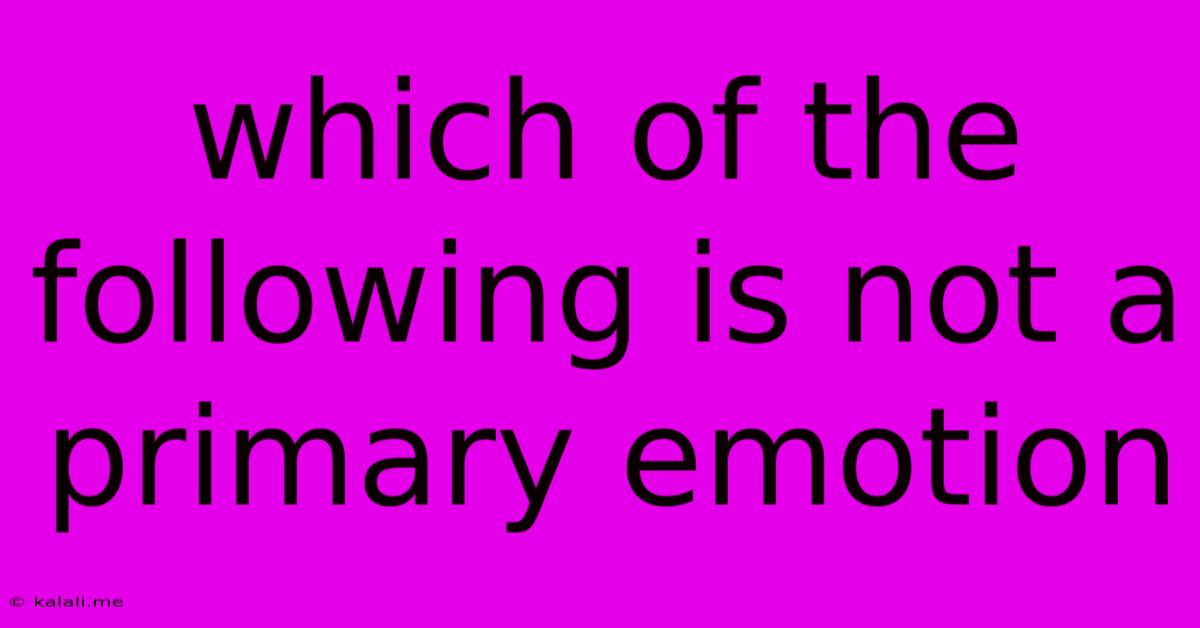Which Of The Following Is Not A Primary Emotion
Kalali
Jun 12, 2025 · 3 min read

Table of Contents
Which of the Following is Not a Primary Emotion? Understanding Basic Human Feelings
Meta Description: This article explores the concept of primary emotions, differentiating them from secondary emotions. We'll delve into the six universally recognized primary emotions and explain why others are considered secondary or blended emotions. Learn to identify and understand the fundamental building blocks of human feeling.
The question "Which of the following is not a primary emotion?" requires understanding what constitutes a primary emotion in the first place. While there isn't complete consensus among all psychologists, the most widely accepted model identifies six primary emotions. These are considered fundamental and universal, meaning they are experienced across cultures and are not derived from other emotions. Understanding this distinction helps us better navigate our own emotional landscape and the emotions of others.
What are Primary Emotions?
Primary emotions are considered basic, innate, and universally expressed. They are believed to be biologically programmed, rather than learned. These emotions typically manifest with distinct facial expressions and physiological responses, making them relatively easy to identify. Key characteristics of primary emotions include:
- Universality: Expressed similarly across different cultures.
- Innate: Present from birth or very early childhood.
- Distinct Physiological Responses: Accompanied by specific changes in heart rate, breathing, and hormone levels.
- Automatic and Unconscious: Often experienced spontaneously and without conscious thought.
The Six Primary Emotions
Most researchers agree on these six emotions as primary:
- Happiness: Characterized by feelings of joy, contentment, and pleasure.
- Sadness: Associated with feelings of loss, disappointment, and grief.
- Anger: Marked by feelings of hostility, irritation, and aggression.
- Fear: Involves feelings of apprehension, anxiety, and threat.
- Surprise: A response to unexpected events, marked by sudden alertness and widened eyes.
- Disgust: Characterized by feelings of revulsion and aversion, often associated with unpleasant smells, tastes, or sights.
Secondary Emotions: A Blend of Feelings
Secondary emotions are more complex and are often considered to be combinations or blends of primary emotions. They are learned and developed through experience and social interaction. Examples of secondary emotions include:
- Guilt: Often a combination of sadness and fear of consequences.
- Shame: A blend of sadness, anger turned inward, and fear of judgment.
- Jealousy: May involve anger, sadness, and fear of loss.
- Pride: Often linked to happiness and self-satisfaction.
- Love: A complex emotion incorporating happiness, trust, and attachment.
- Embarrassment: A mixture of fear, shame, and surprise.
Identifying Non-Primary Emotions
To determine which emotion from a given list is not primary, examine its characteristics. Ask yourself: Is it universally expressed? Is it innate or learned? Is it a simple feeling or a blend of other emotions? If an emotion displays characteristics of complexity and learned behavior, it's highly likely to be a secondary emotion. Understanding the nuances of primary versus secondary emotions allows for a more nuanced understanding of human behavior and emotional expression.
This knowledge is useful in various fields, including psychology, communication, and even artificial intelligence (AI) development in emotional recognition. The better we grasp the fundamental building blocks of emotion, the better we can interact with and understand others.
Latest Posts
Latest Posts
-
What Is The First Step Of Research
Jun 13, 2025
-
Where Is The Indo Gangetic Plain Located
Jun 13, 2025
-
How Many Kg Is 350 Pounds
Jun 13, 2025
-
How Does Adaptive Radiation Compare To Convergent Evolution
Jun 13, 2025
-
About 97 5 Of Earths Water Is
Jun 13, 2025
Related Post
Thank you for visiting our website which covers about Which Of The Following Is Not A Primary Emotion . We hope the information provided has been useful to you. Feel free to contact us if you have any questions or need further assistance. See you next time and don't miss to bookmark.